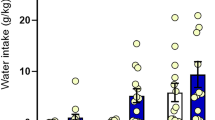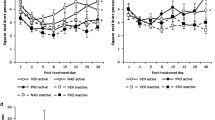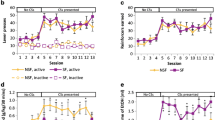Abstract
Rationale
In humans, the retrieval of memories associated with an alcohol-related experience frequently evokes alcohol-seeking behaviour. The reconsolidation hypothesis states that a consolidated memory could again become labile and susceptible to disruption after memory retrieval.
Objectives
The aim of our study was to examine whether retrieval of alcohol-related memories undergoes a reconsolidation process.
Methods
For this purpose, male Wistar rats were trained to self-administer ethanol in the presence of specific conditioned stimuli. Thereafter, animals were left undisturbed in their home cages for the following 21 days. Memory retrieval was performed in a single 5-min exposure to all alcohol-associated stimuli. The protein synthesis inhibitor anisomycin, the non-competitive N-methyl-d-aspartate (NMDA) receptor antagonist MK-801 and acamprosate, a clinically used drug known to reduce a hyper-glutamatergic state, were given immediately after retrieval of alcohol-related memories. The impact of drug treatment on cue-induced alcohol-seeking behaviour was measured on the following day and 7 days later.
Results
Administration of both anisomycin and MK-801 reduced cue-induced alcohol-seeking behaviour, showing that memory reconsolidation was disrupted by these compounds. However, acamprosate had no effect on the reconsolidation process, suggesting that this process is not dependent on a hyper-glutamatergic state but is more related to protein synthesis and NMDA receptor activity.
Conclusions
Pharmacological disruption of reconsolidation of alcohol-associated memories can be achieved by the use of NMDA antagonists and protein synthesis inhibitors and may thus provide a potential new therapeutic strategy for the prevention of relapse in alcohol addiction.




Similar content being viewed by others
References
Bachteler D, Economidou D, Danysz W, Ciccocioppo R, Spanagel R (2005) The effects of acamprosate and neramexane on cue-induced reinstatement of ethanol-seeking behavior in rat. Neuropsychopharmacology 30:1104–1110
Bernardi RE, Lattal KM, Berger SP (2007) Anisomycin disrupts a contextual memory following reactivation in a cocaine-induced locomotor activity paradigm. Behav Neurosci 121:156–163
Biała G, Kotlińska J (1999) Blockade of the acquisition of ethanol-induced conditioned place preference by N-methyl-D-aspartate receptor antagonists. Alcohol Alcohol 34:175–182
Cami J, Farre M (2003) Drug addiction. N Engl J Med 349(10):975–986
Debiec J, LeDoux JE, Nader K (2002) Cellular and systems reconsolidation in the hippocampus. Neuron 36:527–538
Dudai Y (2004) The neurobiology of consolidations, or, how stable is the engram? Annu Rev Psychol 55:51–86
Duvarci S, Nader K (2004) Characterization of fear memory reconsolidation. J Neurosci 24:9269–9275
Füllgrabe MW, Vengeliene V, Spanagel R (2007) Influence of age at drinking onset on the alcohol deprivation effect and stress-induced drinking in female rats. Pharmacol Biochem Behav 86:320–326
Hellemans KG, Everitt BJ, Lee JL (2006) Disrupting reconsolidation of conditioned withdrawal memories in the basolateral amygdala reduces suppression of heroin seeking in rats. J Neurosci 26:12694–12699
Hyman SE, Malenka RC, Nestler EJ (2006) Neural mechanisms of addiction: the role of reward-related learning and memory. Annu Rev Neurosci 29:565–598
Kelley AE (2004) Memory and addiction: shared neural circuitry and molecular mechanisms. Neuron 44:161–179
Kelley JB, Anderson KL, Itzhak Y (2007) Long-term memory of cocaine-associated context: disruption and reinstatement. NeuroReport 18:777–780
Lattal KM, Abel T (2004) Behavioral impairments caused by injections of the protein synthesis inhibitor anisomycin after contextual retrieval reverse with time. Proc Natl Acad Sci USA 101:4667–4672
Lee JL, Everitt BJ (2008) Appetitive memory reconsolidation depends upon NMDA receptor-mediated neurotransmission. Neurobiol Learn Mem 90:147–154
Lee JL, Di Ciano P, Thomas KL, Everitt BJ (2005) Disrupting reconsolidation of drug memories reduces cocaine-seeking behavior. Neuron 47:795–801
Lee JL, Milton AL, Everitt BJ (2006a) Cue-induced cocaine seeking and relapse are reduced by disruption of drug memory reconsolidation. J Neurosci 26:5881–5887
Lee JL, Milton AL, Everitt BJ (2006b) Reconsolidation and extinction of conditioned fear: inhibition and potentiation. J Neurosci 26:10051–10056
McGaugh JL (2000) Memory—a century of consolidation. Science 287:248–251
Milekic MH, Brown SD, Castellini C, Alberini CM (2006) Persistent disruption of an established morphine conditioned place preference. J Neurosci 26:3010–3020
Miller CA, Marshall JF (2005) Molecular substrates for retrieval and reconsolidation of cocaine-associated contextual memory. Neuron 47:873–884
Milton AL, Lee JL, Butler VJ, Gardner R, Everitt BJ (2008) Intra-amygdala and systemic antagonism of NMDA receptors prevents the reconsolidation of drug-associated memory and impairs subsequently both novel and previously acquired drug-seeking behaviors. J Neurosci 28:8230–8237
Misanin JR, Miller RR, Lewis DJ (1968) Retrograde amnesia produced by electroconvulsive shock after reactivation of a consolidated memory trace. Science 160:554–555
Nader K, Schafe GE, Le Doux JE (2000) Fear memories require protein synthesis in the amygdala for reconsolidation after retrieval. Nature 406:722–726
O'Brien CP, Childress AR, McLellan AT, Ehrman R (1992) Classical conditioning in drug-dependent humans. Ann N Y Acad Sci 654:400–415
Pedreira ME, Maldonado H (2003) Protein synthesis subserves reconsolidation or extinction depending on reminder duration. Neuron 38:863–869
Power AE, Berlau DJ, McGaugh JL, Steward O (2006) Anisomycin infused into the hippocampus fails to block “reconsolidation” but impairs extinction: the role of re-exposure duration. Learn Mem 13:27–34
Przybyslawski J, Sara SJ (1997) Reconsolidation of memory after its reactivation. Behav Brain Res 84:241–246
Riedel G, Platt B, Micheau J (2003) Glutamate receptor function in learning and memory. Behav Brain Res 140:1–47
Robinson MJ, Franklin KB (2007) Effects of anisomycin on consolidation and reconsolidation of a morphine-conditioned place preference. Behav Brain Res 178:146–153
Sadler R, Herzig V, Schmidt WJ (2007) Repeated treatment with the NMDA antagonist MK-801 disrupts reconsolidation of memory for amphetamine-conditioned place preference. Behav Pharmacol 18:699–703
Samson HH (1986) Initiation of ethanol reinforcement using a sucrose-substitution procedure in food- and water-sated rats. Alcohol Clin Exp Res 10:436–442
Sanchis-Segura C, Spanagel R (2006) Behavioural assessment of drug reinforcement and addictive features in rodents: an overview. Addict Biol 11:2–38
Spanagel R (2009) Alcoholism—a systems approach from molecular physiology to behavior. Physiol Rev 89:649–705
Spanagel R, Kiefer F (2008) Drugs for relapse prevention of alcoholism—10 years of progress. Trends Pharmacol Sci 29:109–115
Spanagel R, Pendyala G, Abarca C, Zghoul T, Sanchis-Segura C, Magnone MC, Lascorz J, Depner M, Holzberg D, Soyka M, Schreiber S, Matsuda F, Lathrop M, Schumann G, Albrecht U (2005) The circadian clock gene Period2 alters the glutamatergic system and thereby modulates alcohol consumption. Nat Med 11:35–42
Spanagel R, Zieglgänsberger W, Hundt W (1996) Acamprosate and alcohol: III. Effects on alcohol discrimination in the rat. Eur J Pharmacol 305:51–56
Torras-Garcia M, Lelong J, Tronel S, Sara SJ (2005) Reconsolidation after remembering an odor-reward association requires NMDA receptors. Learn Mem 12:18–22
Tronson NC, Taylor JR (2007) Molecular mechanisms of memory reconsolidation. Nat Rev Neurosci 8:262–275
Tzschentke TM (2007) Measuring reward with the conditioned place preference (CPP) paradigm: update of the last decade. Addict Biol 12:227–462
Valjent E, Corbille AG, Bertran-Gonzalez J, Herve D, Girault JA (2006) Inhibition of ERK pathway or protein synthesis during reexposure to drugs of abuse erases previously learned place preference. Proc Natl Acad Sci USA 103:2932–2937
Vengeliene V, Heidbreder CA, Spanagel R (2007) The effect of lamotrigine on alcohol seeking and relapse. Neuropharmacology 53:951–795
Acknowledgements
We thank Sabrina Koch and Elisabeth Röbel for excellent technical assistance. This work was supported by two SFB636 grants—B1 given to RS and D6 given to FK.
Author information
Authors and Affiliations
Corresponding author
Additional information
C. von der Goltz and V. Vengeliene contributed equally to this work.
Rights and permissions
About this article
Cite this article
von der Goltz, C., Vengeliene, V., Bilbao, A. et al. Cue-induced alcohol-seeking behaviour is reduced by disrupting the reconsolidation of alcohol-related memories. Psychopharmacology 205, 389–397 (2009). https://doi.org/10.1007/s00213-009-1544-1
Received:
Accepted:
Published:
Issue Date:
DOI: https://doi.org/10.1007/s00213-009-1544-1




